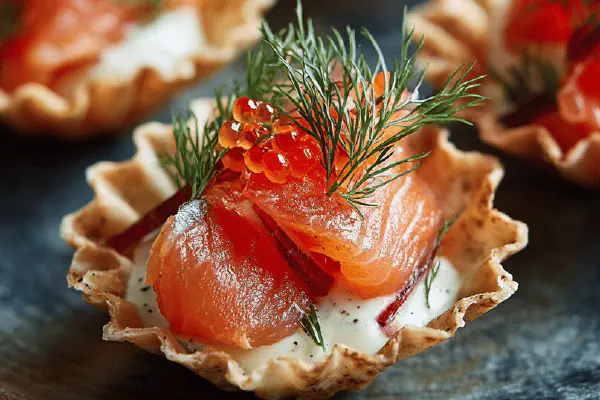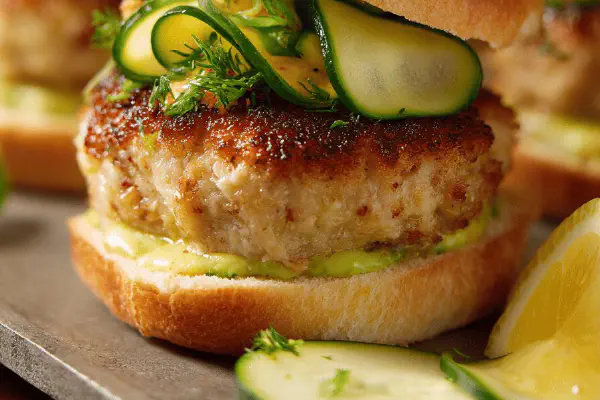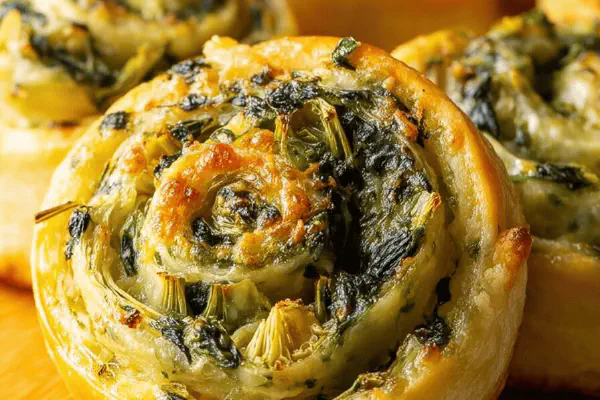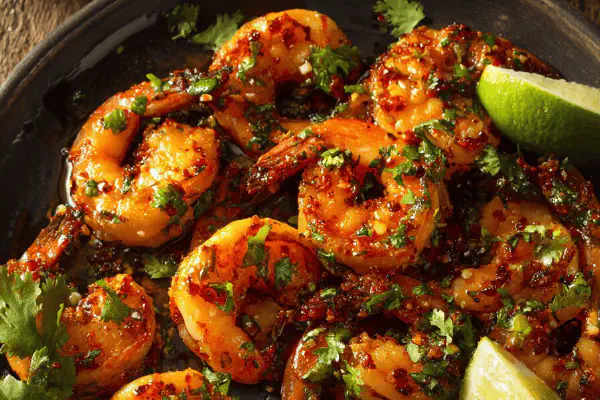Salmon Gravlax Canapés

E
By Emma
Certified Culinary Professional
•
Recipe tested & approved
Cured salmon flavored with fresh dill, citrus zest, and a touch of gin. Served on crisp shells with a tangy mustard cream. No eggs or nuts. Small bites with a bright, fresh aroma. A balance of creamy, salty, and citrusy. Requires 23-25 hours total including refrigeration. Serves about 36 pieces. Scandinavian-inspired but with a French twist. Uses vodka instead of gin for a lighter lift. Classic texture contrasts - silky fish, airy cream, crunchy base. Garnish optional but impactful. Quick whip and fold technique for cream ensures light texture. Moderate effort, great for entertaining.
Prep:
45 min
Cook:
0 min
Total:
Servings:
36 servings
#seafood
#appetizers
#Scandinavian Cuisine
#French Twist
#cocktail bites
#cured fish
#party food
Cold cured salmon has obsessed me for years. At first, I bungled the salt-sugar balance; too salty, or bland and wet. The zest aromatics? Game changer. Lemon brightens, orange mellows. Dill — no skimping. Gin always seemed right: but overpowered. Vodka offers subtle lift. Texture? Cure fish thin, press weight firmly. The fridge hums, 22 hours minimum for that perfect bite. Crisp shell needed to contrast luscious cream and silky fish. Mustard cream is sharp, creamy; whip cream soft, never stiff. Fold carefully — air and texture critical. Garnishes? I add fish roe sometimes; pops like tiny fireworks. Keep shells dry until last. Makes entertaining easy. Sensory cues over clocks; salmon yielding but firm, cream glossy peaks, smell fresh, feel light crunch. Simple but precise.
Ingredients
- 15 ml fresh dill chopped
- 6 ml sea salt coarse
- 7 ml brown sugar packed
- 5 ml zest from lemon
- 5 ml zest from orange
- 1 ml cracked black pepper
- 330 g skinless salmon fillet 1 cm thick slices
- 15 ml vodka or aquavit
- 110 ml heavy cream 38%
- 25 ml whole grain mustard
- 36 store-bought crispy shells
- Sprigs of dill for garnish
- Optional fish roe for topping
About the ingredients
Changed salt coarse for better even cure, brown sugar for richer flavor over white. Citrus twist: lemon and orange zests replace lemon and clementine for deeper aroma layers. Vodka swapped for aquavit once: added anise and herbal tones but not for timid palates. Cream 38% more stable than 35%; easier whip. Mustard grainy for texture, a smoother Dijon is more subdued. Shells from store to save time but watch thickness to avoid soggy bottoms. No eggs or nuts keeps allergy safe. Salmon quality paramount: fresh, firm flesh, de-boned, skin removed to avoid chewiness and bitterness. Herbs like dill must be fresh; dried won’t cut. Optional roe I use for color and ocean salt pop but never necessary. Planning ahead? Cure salmon day before; can keep cream and shells separate hours. Avoid soggy canapés. These swaps lend layered flavor without complexity.
Method
Salmon Gravlax
- Mix dill salt sugar lemon zest orange zest pepper in small bowl. Aroma should pop, fresh and citrusy with spice bite.
- Lay salmon flat single layer in glass container ~28x20 cm. Pour vodka evenly. Sprinkle herb-salt mixture carefully, cover salmon completely but avoid clumps.
- Cover with plastic wrap. Place weight on top like another glass dish same size. Press gently but firmly. Store in fridge 22-26 hours. Check once after 12 hours, drain excess moisture if needed.
- Remove weight and plastic. Pat salmon dry with paper towels to avoid soggy cream later.
- Cut salmon into small cubes about 0.7 cm. Chill until ready to assemble.
Canapés
- Whip cream until soft peaks form; better stop before stiff. Fold in mustard gently using spatula to keep airiness. Should have gentle tang, not overpowering.
- Spoon or pipe a dollop of mustard cream into each shell bottom. Heap small spoonful of gravlax cubes over cream. Garnish each with dill sprig and optional fish roe for color and salt punch.
- Serve immediately for best crunch. If prepping early, keep shells separate from filling to avoid sogginess.
Notes
- Salmon texture key. Over-curing makes rubbery. Under-curing, too soft and bland. Weight application critical. Without a firm press, uneven cure happens.
- Vodka gives clean palate, shots of gin bring piney notes but can dominate citrus. Aquavit adds complexity but not for everyone.
- Mustard cream can be swapped for crème fraîche with herbes de Provence if you want more earthiness.
- In a pinch, smoked salmon cubes replace gravlax but lose fresh citrus.
Cooking tips
Preparation will test patience; curing needs no shortcuts. Herb-salt mix pulverizes brightness into flesh; without weight, uneven texture and flavor. I learned to halve thickness, spreading slices evenly. Gin or vodka sprayed, never drowned, avoids waterlogging. Cover tightly so salmon doesn’t pick fridge odors. Weight application critical: use glass dish, even stack of cans works but glass better for even pressure. After curing, pat salmon dry - moisture ruins cream and shells. Dice uniformly; bite-sized pieces ease eating, prevent cream-to-fish imbalance. Whip cream to soft peaks only; stiff cream turns heavy and clumpy, folding mustard slowly preserves lift. Spoon or pipe cream in layers; helps keep shell crisp. Assemble just before serving; shells fail after 30 minutes resting with moist filling. Garnishes add brightness and color; dill sprigs hold aroma when eaten. Roe optional but adds exciting salty bursts. If pressed for time, smoked salmon is quick substitute but less fresh, no curing magic. Always focus on tactile and aroma indicators - that’s the real test in kitchen.
Chef's notes
- 💡 Weight on salmon crucial. Without firm press, cure uneven; soft spots and dryness combine. Use glass dish or dense cans stacked carefully. Press gently but steady; too hard squishes texture. Check mid-cure, drain moisture or fish gets rubbery. Thickness matters; halve if unsure. Thin slides, even layers let cure penetrate fully. Skip clumps of herb-salt mix, spreads flavor better evenly.
- 💡 Whip cream till soft peaks; stop before stiff. Over-whip makes heavy mouthfeel, kills light texture. Folding in mustard slow, gentle to keep air trapped. Grainy mustard adds chew contrast; Dijon smoother but less punch. Cream fat percentage slightly higher makes whipping stable. Whip cold; bowl and beaters chilled help. Keeps cream glossy, not broken or watery.
- 💡 Cure timing flexible; 22 to 26 hours best. Shorter—fish soft, lacks flavor. Longer—and chewy. Fridge steady temp only; opening door releases chill, affects cure. Slice salmon 1 cm thick; thicker slows salt penetration, thinner dries out fast. Vodka choice affects taste; aquavit herbs change tone, gin piney overpower citrus zest sometimes. Choose tailored to final flavor balance.
- 💡 Assemble canapés last minute. Crisp shells soak liquid fast; cream and fish moisture ruin crunch. Store filling cold separately. If prepping early, keep shells in sealed container, dry, cool spot. Dollop cream first, then fish cubes piled small; too much means imbalance. Garnish dill sprigs fresh, aroma bursts on bite. Roe optional; adds brine pop but can overshadow subtle flavors.
- 💡 Cut salmon uniform cubes; bite size. Too big overwhelms shell, too small loses texture contrast. Pat dry after cure; moisture kills cream texture, soggy shells follow. Use paper towels gently, no rubbing to keep surface intact. Fish should feel firm but yielding, glossy. Aroma sharp but not salty or musty. Smell cues tell when to stop curing; citrus zest scent mixed with dill sharpness signals readiness.
Common questions
How long to cure salmon?
Around 22 to 26 hours fridge. Shorter? Soft, underflavored. Longer? Firm, dry. Temp stable fridge important; no opening often. Thickness matters too; 1 cm standard work well.
Can I swap vodka for something else?
Yes, aquavit for herbal complexity; adds anise notes. Gin brings piney sharpness, can overwhelm zest. No alcohol? Skip but less lift, adjust herb mix maybe.
What if cream breaks?
Stop whipping at soft peaks. If broken, chill bowl, whisk again gently. Folding mustard slow helps keep air. Use fresh cream high fat, 38% better hold than 35%.
How to keep shells crisp?
Store shells airtight, dry until last. Fill just before serving. Keep filling and shells separate. If prepping hours ahead, refrigerate filling, shells room temp dry. No mix until serving prevents sogginess.



